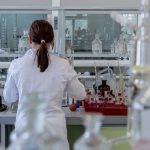How is HOCl manufactured?

Hypochlorous Acid (HOCl) has traditionally been produced by a method called “electrolysis.” The word “lysis” means to separate or to break, and electrolysis enables the separation of elements from naturally occurring sources using an electric cell. The technology was first developed by Michael Faraday in 1834, and since then, it has become an essential technique for many commercial applications and research.(1) This technique uses a direct electric current (DC) to drive an otherwise non-spontaneous chemical reaction.(2,3) Electrolysis of sodium chloride (NaCl) and water (H2O) enables the generation of HOCl.
Unfortunately, this method of HOCl production is problematic. Traditional electrolysis machines generate HOCl in a chamber where a diaphragm or membrane is placed between the cathode and anode. As HOCl is highly dependent on pH (HOCl predominantly exists between a pH of 3.5 to 5.5), the challenge with this technique is that pH may be difficult to control during the manufacturing process, yielding an unstable HOCl product. This means that the HOCl product produced by electrolysis has been reported to be more likely to break down into chlorine or bleach over time. Another problem with electrolysis is the difficulty in controlling the target concentration during manufacturing, yielding lower concentrations of HOCl.(4) The process can also produce a HOCl product containing impurities, sometimes at high levels. Additionally, producing HOCl by electrolysis can produce byproducts that can be toxic to human health and the environment. These byproducts include chlorine gas, sodium hypochlorite (bleach), sodium hydroxide, hydrogen gas, ozone, and traces of other nascent oxidants.
Newer electrolysis techniques utilizing a single-cell chamber have been developed, improving stability. For example, compared to traditional electrolysis-based manufacturing of HOCl, however, this technique has been reported to produce a slightly acidic HOCl solution with a pH range of 5.0 to 6.5. (5) HOCl can also be produced by a process called “hydrolysis” of chlorine; however, this involves handling of chlorine gas which can be hazardous and poses difficulty in manipulation. Another method for manufacturing HOCl involves the “acidification” of a hypochlorite solution; however, this involves handling a toxic solution mixed with sodium hypochlorite. This requires careful titration to a target pH level, which can be challenging with the production of large quantities of HOCl. Additionally, the final HOCl product may contain impurities. Developing novel technologies that can produce large volumes of stable, pure, high-efficacy HOCl that involve an environmentally safe manufacturing process is crucial to meet increasing population demands in multiple industries.
Such a technology only existed commercially recently. The development of large-scale manufacturing plants utilizing novel “ion exchange” technology by leading companies such as Hypristine has revolutionized the HOCl industry. Ion exchange is a process where one type of ion is exchanged for another using columns containing specialized ion-exchange resin. This HOCl manufacturing technique now enables the manufacturing of large volumes of consistent, high-quality, pure HOCl with remarkable stability and efficacy that has been reported to outperform traditional electrolysis-based manufacturing methods. Additionally, the technology enables the generation of higher concentrations of HOCl beyond what traditional electrolysis methods can produce. Another benefit is that the manufacturing process virtually eliminates the generation of toxic byproducts, thereby being safe for manufacturing staff and the environment. The development of next-generation ion-exchange-based HOCl manufacturing systems will now set new industry standards and will be critical to help ensure public health.
References:
- Funke, K. Solid State Ionics: from Michael Faraday to green energy-the European dimension. Sci Technol Adv Mater 14, 043502 (2013).
- Chen, B.K. & Wang, C.K. Electrolyzed Water and Its Pharmacological Activities: A Mini-Review. Molecules 27(2022).
- Shih, A.J., et al. Water electrolysis. Nature Reviews Methods Primers 2, 84 (2022).
- Wang, L., et al. Hypochlorous acid as a potential wound care agent: part I. Stabilized hypochlorous acid: a component of the inorganic armamentarium of innate immunity. J Burns Wounds 6, e5 (2007).
- Yaqub, M., Woo, C. & Lee, W. Optimization of hypochlorous acid generation by HCl electrolysis through response surface methodology and artificial neural networks. Journal of Environmental Chemical Engineering 9, 105826 (2021).






